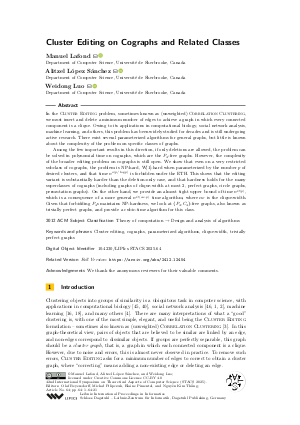LIPIcs.STACS.2025.64.pdf
- Filesize: 0.91 MB
- 21 pages

 Creative Commons Attribution 4.0 International license
Creative Commons Attribution 4.0 International license

In the Cluster Editing problem, sometimes known as (unweighted) Correlation Clustering, we must insert and delete a minimum number of edges to achieve a graph in which every connected component is a clique. Owing to its applications in computational biology, social network analysis, machine learning, and others, this problem has been widely studied for decades and is still undergoing active research. There exist several parameterized algorithms for general graphs, but little is known about the complexity of the problem on specific classes of graphs.
Among the few important results in this direction, if only deletions are allowed, the problem can be solved in polynomial time on cographs, which are the P₄-free graphs. However, the complexity of the broader editing problem on cographs is still open. We show that even on a very restricted subclass of cographs, the problem is NP-hard, W[1]-hard when parameterized by the number p of desired clusters, and that time n^o(p/log p) is forbidden under the ETH. This shows that the editing variant is substantially harder than the deletion-only case, and that hardness holds for the many superclasses of cographs (including graphs of clique-width at most 2, perfect graphs, circle graphs, permutation graphs). On the other hand, we provide an almost tight upper bound of time n^O(p), which is a consequence of a more general n^O(cw⋅p) time algorithm, where cw is the clique-width. Given that forbidding P₄s maintains NP-hardness, we look at {P₄, C₄}-free graphs, also known as trivially perfect graphs, and provide a cubic-time algorithm for this class.














Feedback for Dagstuhl Publishing